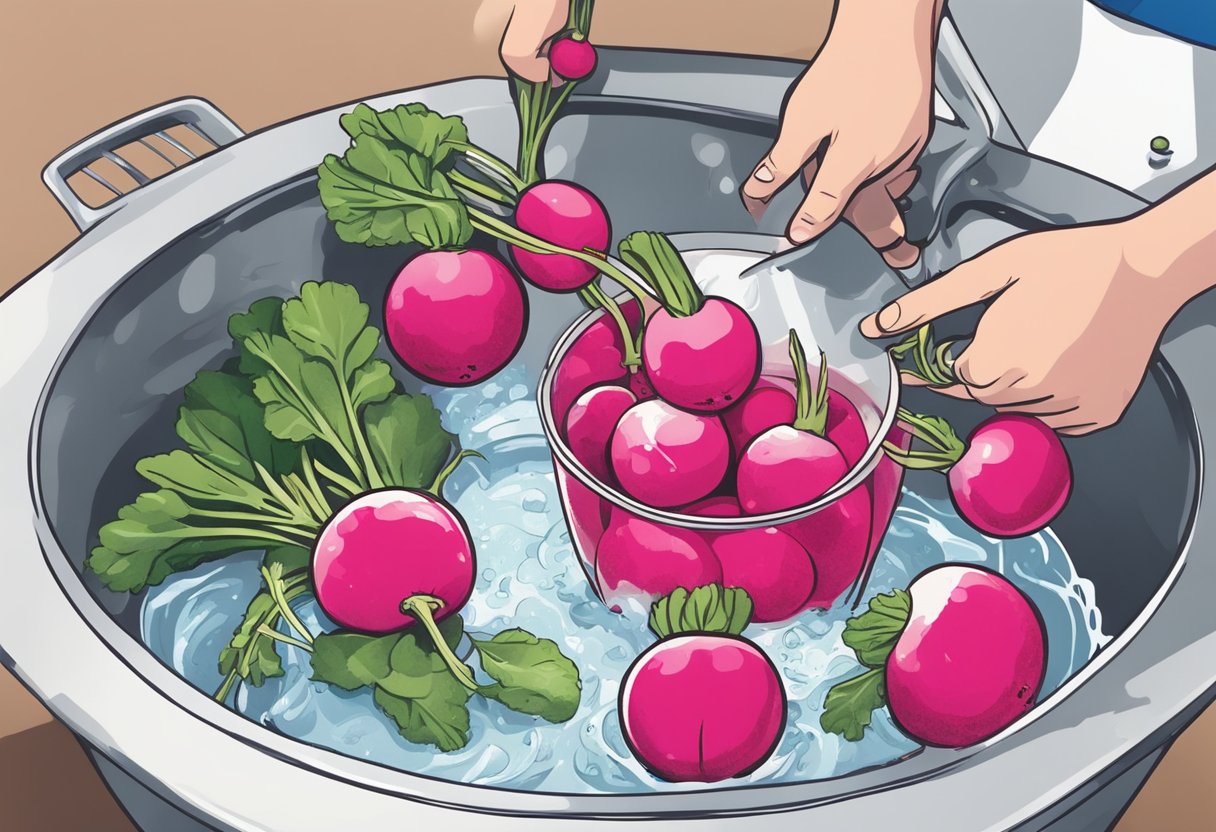Thinning radishes is a crucial step I always follow when tending to my vegetable garden. Radishes require space to grow and can become stunted if crowded. By selectively removing some young plants, I ensure the remaining radishes have enough room to develop fully. This process not only helps to produce a more abundant harvest but also prevents the spread of disease that can occur when plants are too dense.

In my experience, the timing of thinning radishes is almost as important as the act itself. I typically thin them out once the seedlings have sprouted and are a couple of inches tall. This allows me to clearly distinguish which seedlings are the strongest. I identify the most robust specimens to keep and carefully remove the weaker ones, which guarantees that my garden is populated with the healthiest and most vigorous plants. Maintaining proper spacing between radishes contributes to their optimal growth and results in a vegetable that’s crisp and full-flavored when harvested.
JUMP TO TOPIC
Cultivating Radishes
Radishes are a fast-growing crop that thrive in cool conditions, and successful cultivation depends on the right soil, sowing techniques, and proper watering.
Choosing the Right Soil and Conditions
I understand that to ensure the best growth, radishes require well-drained soil enriched with organic matter. Before planting, I like to work in some compost to help with soil structure and nutrient content. Radishes grow best in full sun, though they can tolerate partial shade.
💥 Ideal Soil Mix for Radishes:
- 50% garden soil
- 40% compost
- 10% perlite or sand for drainage
Sowing and Spacing Techniques
I prefer direct-sow seeds in spring or late summer for a fall harvest. For sowing radishes, the seeds should be spaced accurately to prevent overcrowding.
For traditional sowing, space seeds 1 inch apart and thin to 2 inches. For multisowing, cluster 3-4 seeds together, spacing clusters 4-6 inches apart.
Watering and Maintaining Moisture
Radishes require even moisture to develop well. I make sure to keep the soil moist, especially just after sowing seeds. Watering should be consistent but not excessive. For my garden, mulching is vital to retain soil moisture and regulate soil temperature.
| Weeks After Sowing | Watering Frequency | Amount of Water | Notes |
|---|---|---|---|
| 1-2 | Daily | Light | Keep surface moist |
| 3-4 | Every 2-3 Days | Deeper | Encourage root growth |
| 5 until harvest | As required | Deep | Avoid water stress |
Harvesting and Post-Care
After meticulously tending to your radish crop, thinning them to prevent crowded conditions and ensure robust growth, it’s pivotal to recognize the opportune moment for harvesting. I’ll cover the best practices for determining the right harvest time and dealing with potential post-harvest concerns like pests and problems.
Determining the Right Time to Harvest
The ideal time to harvest radishes largely depends on the variety and its time to maturity, which often ranges from 22 to 30 days for spring types and up to 60 days or more for winter varieties. I look for telltale signs; a visible shoulder of the radish peeking through the soil surface or when they reach their expected diameter—usually 1 inch for common varieties. Harvesting promptly ensures optimal flavor and texture.
Stunted growth and a woody texture can result from leaving radishes in the ground too long, especially as temperatures rise.
Continuing a harvesting regimen allows for what I like to call a ‘continuous harvest’, whereby younger radishes fill in the space left behind by their predecessors, thus maintaining a consistent supply.
Handling Common Pests and Problems
In my experience, radishes can be trouble-free if grown rapidly in cool weather and fertile soil, but sometimes they do attract pests like flea beetles. Thinning radishes properly reduces competition and improves air circulation, which is vital in managing these pests. For flea beetles, I find that floating row covers are an effective preventive measure.
Maintaining a weed-free environment not only minimizes competition for nutrients but also reduces pest hideouts.
I always keep an eye out for signs of stress in my radishes that can be an indicator of overcrowding or the presence of pests. Healthy plants are the best defense against most garden problems. Proper thinning and timely harvesting play crucial roles in ensuring a bountiful and trouble-free radish crop.
Radish Varieties and Their Unique Characteristics
Radishes come in a variety of shapes, sizes, and flavors, each with its own cultivation needs and culinary uses.
Radishes are not one-size-fits-all; I have discovered that they come in numerous varieties, each with distinct characteristics.
For example, the Cherry Belle is a common variety known for its round, red appearance and crisp texture. It’s often what you’ll find in a supermarket.
In contrast, French Breakfast radishes are more elongated with a mild flavor and typically red with a white tip. I’ve found them to be less peppery than other types, making them suitable for eating raw in salads.
| Variety | Shape | Flavor | Color |
|---|---|---|---|
| Daikon | Long, cylindrical | Mildly sweet | White |
| Watermelon | Globe-shaped | Sweet and spicy | Green to white skin, red interior |
| White Icicle | Long, icicle shaped | Pungent | White |
Winter radishes, such as the Daikon, are typically larger, can be stored for longer periods, and have a milder taste. They are great for cooking or pickling.
💥 Spicy and peppery flavor:
Radishes like the Watermelon radish not only provide a vibrant red interior but also a distinctive spicy and peppery flavor that adds a punch to dishes.
Each radish variety impacts not just the palate but also the way I plant and space them in my garden. Catering to their individual growth needs ensures a bountiful harvest.












